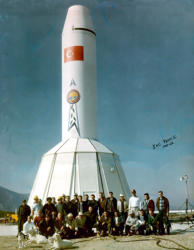
Jupiter SM-78 Weapon System
I&C Team 2, Çigli AB, Turkey 1961-1962 Chrysler Corporation Missile DivisionHISTORY - Page 20
authority, that is, for a field commander, to carry out the order, but a chain of command still existed to
assure that decisions were carried out in the best interest of the program. At the top of program control
was DOD's Ballistic Missile Committee (BMC) and, thence, downward to JANBMC. Subsequently, after the
pull out by the Navy, the joint group was re-designated the Army Ballistic Missile Committee (ABMC). This
management tier provided higher review authority and program control.
Management at the working level was also an important factor. It was imperative that the organization
have "on-the-spot" technical competence for every facet of the development program, and thus the
headquarters staff was organized somewhat differently than normal. Extensive coordination usually
breeds delay, so the move was made to bring the experts of the various technical services and other
organizations to the development installation. In this respect, COE, Transportation Corps, and Signal Corps
were represented. Besides this, representatives of the combat arms and pertinent Department of Army
staff office were domiciled at ABMA. These individuals served in dual roles - staff members of ABMA and
representatives in the interests of their parent organizations. Direct communications were made possible
with all necessary sources, which reduced the reaction time in settling specific technical problems. This
cooperation promoted early and valid decisions with regard to program direction
28
.
______________________________
28. Hist Monograph Nr 3, subj: Spec Powers Delegated to the CG of the ABMA, 1 Feb 56-31 Mar 58, Feb 61, pp. 4-7 & 13-16. Appendix 4 provides the organizational structure under which ABMA functioned during the Army-Navy
cooperative period.









HISTORY - Page 20
authority, that is, for a field commander, to carry out
the order, but a chain of command still existed to
assure that decisions were carried out in the best
interest of the program. At the top of program control
was DOD's Ballistic Missile Committee (BMC) and,
thence, downward to JANBMC. Subsequently, after
the pull out by the Navy, the joint group was re-
designated the Army Ballistic Missile Committee
(ABMC). This management tier provided higher review
authority and program control.
Management at the working level was also an
important factor. It was imperative that the
organization have "on-the-spot" technical
competence for every facet of the development
program, and thus the headquarters staff was
organized somewhat differently than normal.
Extensive coordination usually breeds delay, so the
move was made to bring the experts of the various
technical services and other organizations to the
development installation. In this respect, COE,
Transportation Corps, and Signal Corps were
represented. Besides this, representatives of the
combat arms and pertinent Department of Army
staff office were domiciled at ABMA. These individuals
served in dual roles - staff members of ABMA and
representatives in the interests of their parent
organizations. Direct communications were made
possible with all necessary sources, which reduced
the reaction time in settling specific technical
problems. This cooperation promoted early and valid
decisions with regard to program direction
28
.
______________________________
28. Hist Monograph Nr 3, subj: Spec Powers Delegated to the CG of the ABMA, 1 Feb 56-31 Mar 58, Feb 61, pp. 4-7
&13-16. Appendix 4 provides the organizational structure under which ABMA functioned during the Army-Navy
cooperative period.





















